
Burnout Risk Index
Our interactive Burnout Risk Index, developed with burnout expert Leanne Spencer, reveals 10 red flags which shows that you or a team member may be on the way to burning out.
Resource Guru’s research reveals the extent of the UK’s overworking and burnout issues. We surveyed 2,000 UK desk workers who operate remotely, from an office, or a mix of both. Exposing all aspects of their working lives, we found that overworking is costing both individuals and businesses in the long run. We also collaborated with top industry experts to dig into the data, and share proactive solutions to protect employee wellbeing and business revenue.
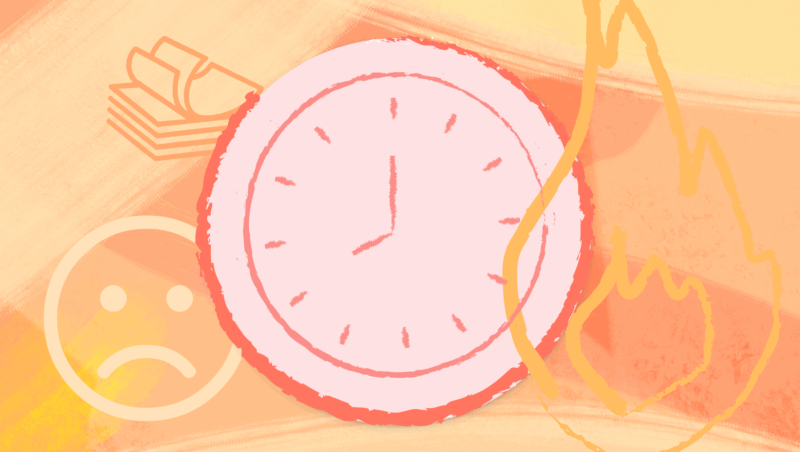
“The issue of overworking and burnout is nothing new, and helping companies to overcome it is something we continue to feel passionately about at Resource Guru.
That is why we commissioned this survey. It’s given us the opportunity to explore beyond the current research out there, and bring together data and subject matter experts to unpack what’s really going on.
Read on to see how we’ve examined the root causes, uncovered the human and business impact, and most importantly, revealed what we can do to safeguard an organization’s people and bottom line.”
Explore our online report to dive into the key datapoints, expert commentary, and the solutions.
We’ve enlisted industry experts to to better understand the data and the UK’s overworking challenges. Here’s who’s on the roster:
More than four in five desk workers (84%) work overtime, and over two thirds (68%) have to work weekends in some capacity.
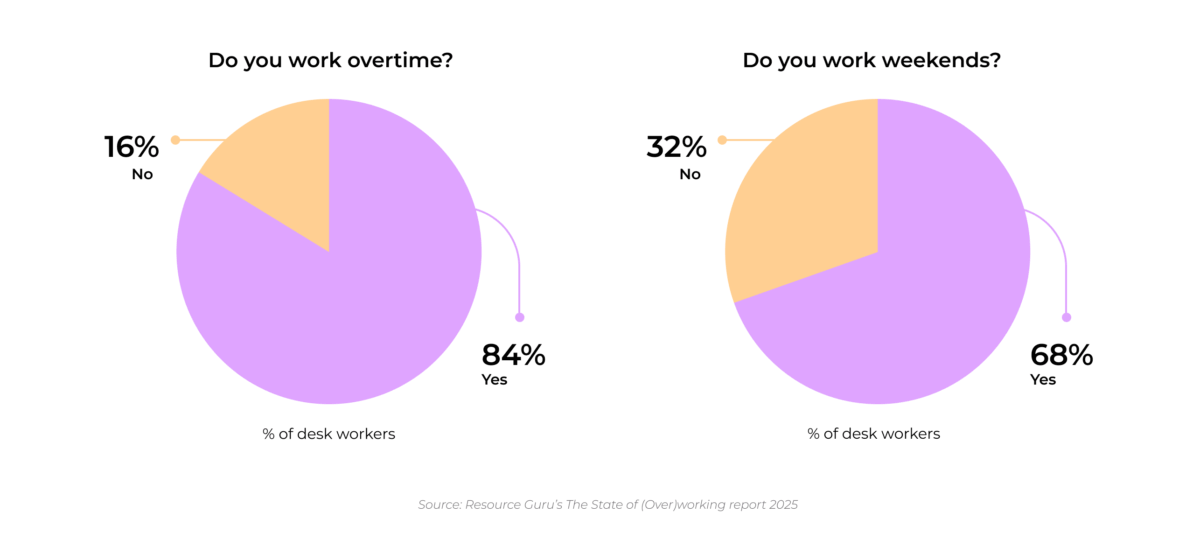
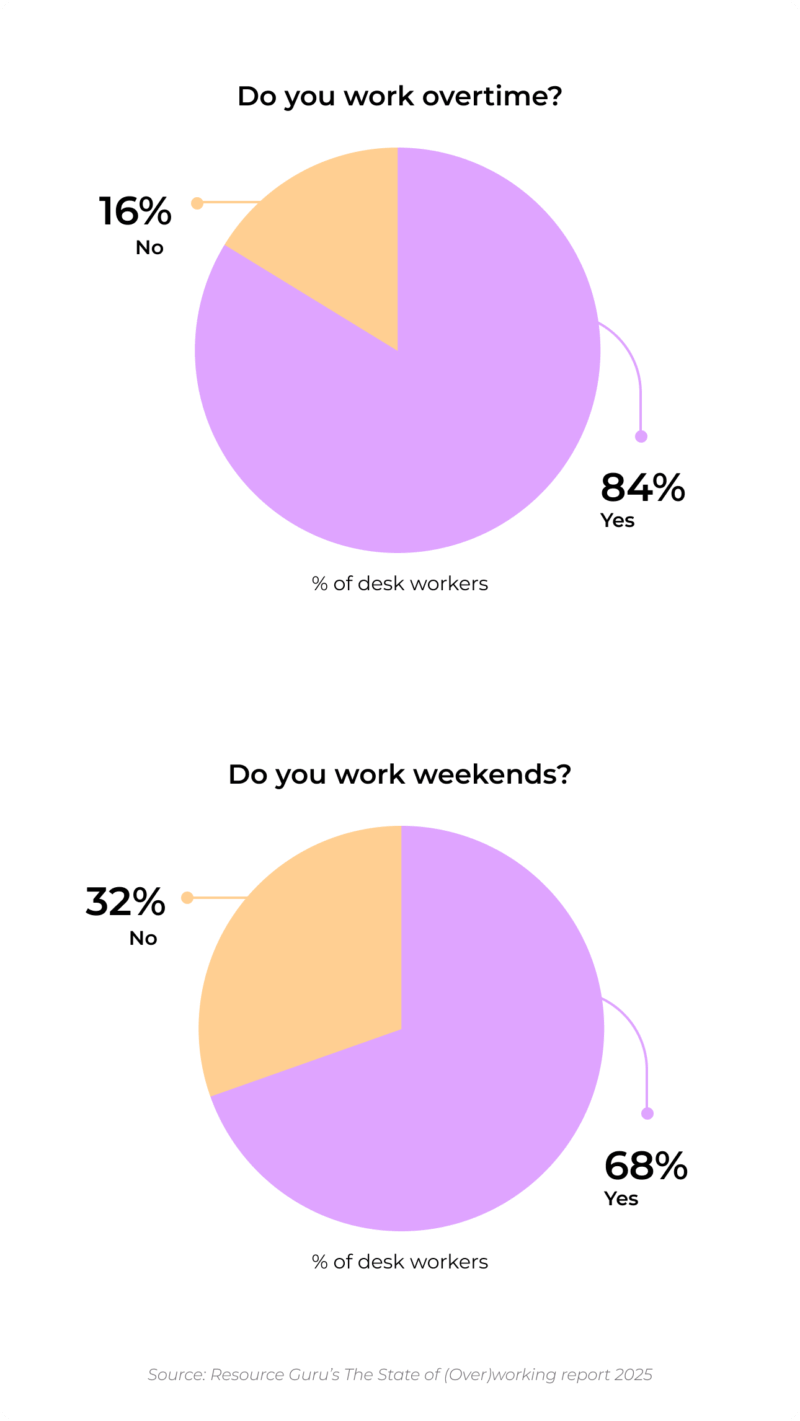
Despite the grind, extra hours aren’t necessarily reflected in employee pay.
It goes without saying: overworking is bad news. But, let’s dig a little deeper.
A large proportion of our survey respondents reported stress and burnout, as well as other serious consequences like anxiety and depression. Our experts have helped us connect the dots between overworking and these issues.
According to Leanne, there are two main reasons why overworking leads to workplace burnout:
We also worked with Leanne to dig into the specific risk factors associated with stress and recovery that can lead to burnout.
Our Burnout Risk Index outlines these. It’s an interactive tool where you can check who’s most at risk of burnout by location in the UK, gender, age, and working arrangement. It can give you a personal indicator into how at risk you might be too, based on these rankings.
Find the answer using our free Burnout Risk Index tool.
Once someone’s burned out, it can lead to them neglecting their desired habits, routines, and overall wellbeing.
“I was hitting 100 hour weeks and completely consumed by work, my brain just shut down. I let myself go (even not caring about my appearance, or the cleanliness of my house). I became a shell of myself! It took a person to tell me how bad I had gotten before I could see it. I then quit and slept for a week!”
– KM, Anonymous
Those who said they were burned out reported the following consequences:
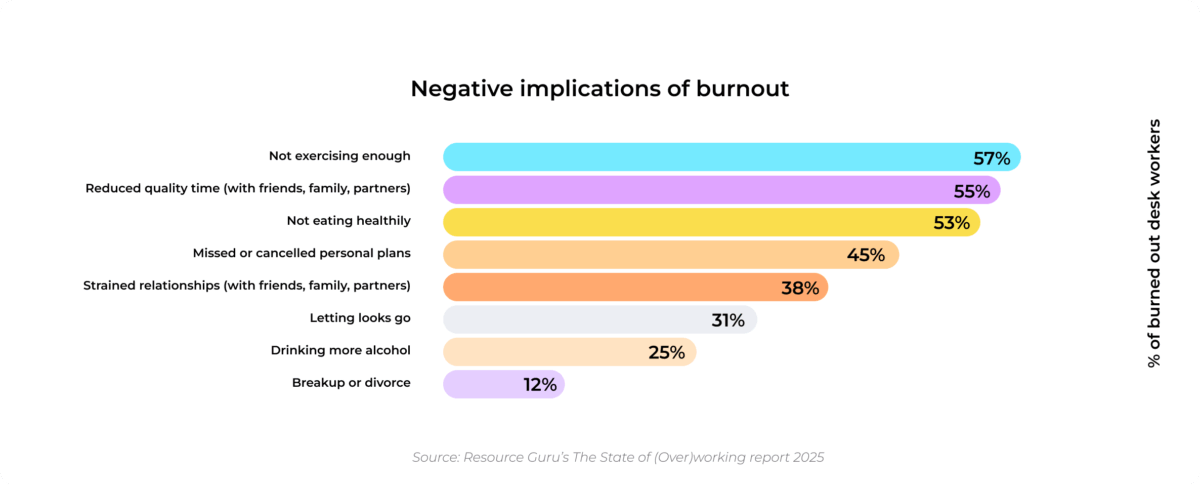
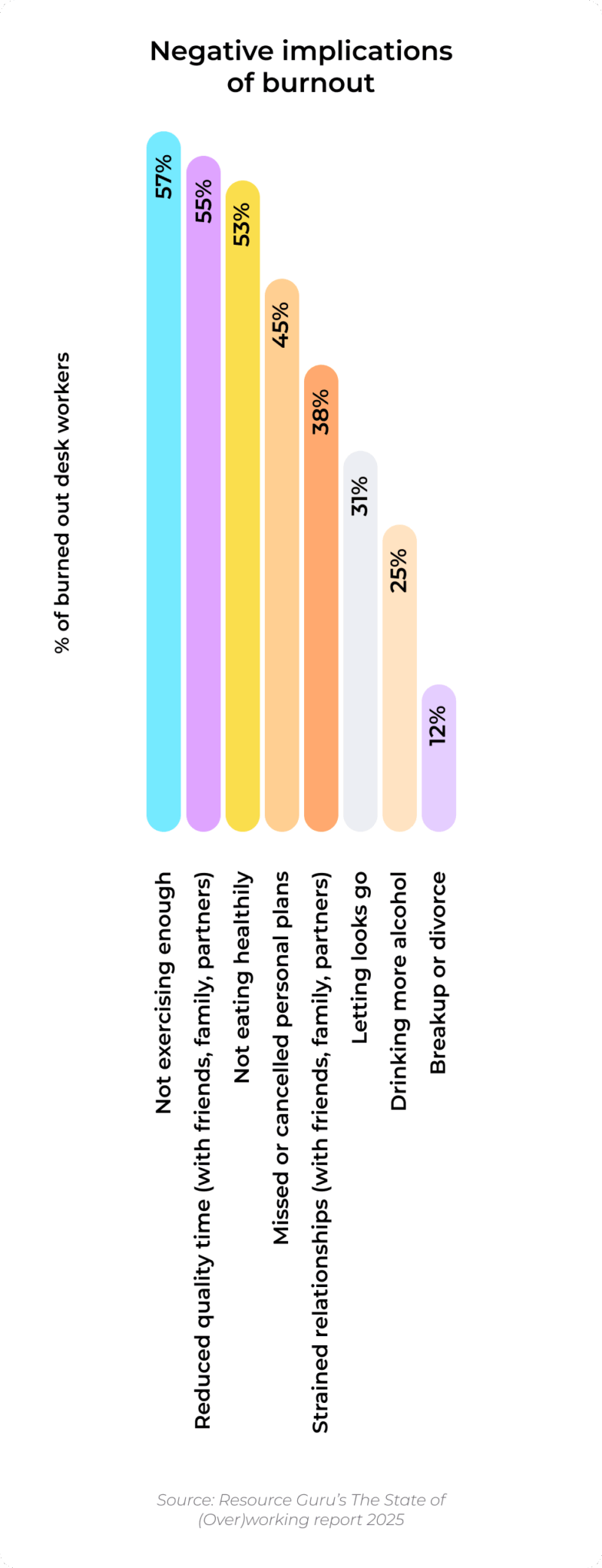
“I used to work for a start-up with a horrific work-life balance. I got caught in a work cycle where the company would offer free Deliveroo dinners to encourage their staff to stay late, so I’d often work until 11pm. I’d feel guilty leaving on time, especially since the CEO saw working late as a sign of good performance.
As a result, I missed social plans, ate poorly, and felt like my only friends were colleagues. The constant stress took a toll, both mentally and physically. It took stepping outside that bubble to realize this isn’t normal or sustainable. Talking to friends outside work helped me see that your work life doesn’t have to be like that.”
– AH, Associate Director of Talent & Culture, Genomics
How burnout and exercise affect each other, according to Matt Anstey 👇
Burnout often leads to feelings of fatigue, apathy, and reduced energy—which can all act as significant barriers to exercising. When someone is burned out, even the thought of physical activity can be overwhelming.
But, reduced physical activity exacerbates burnout symptoms, so it can become a negative loop.
Regular physical exercise can both prevent and combat burnout. Strength training, yoga, and mindfulness-based practices can be particularly beneficial as they focus on body awareness and stress reduction.
For desk workers, small, manageable changes like introducing walking meetings, standing desks, or scheduled stretch breaks throughout the day can be game-changing.
“As a physiotherapist, I’m forever trying to encourage a culture of movement within the workplace in general—especially for those who sit at a desk for most of the day. This can have substantial benefits.” – Matt Anstey
Why burnout and alcohol don’t mix, according to Aron Snowsill 👇
Desk workers may be turning to alcohol when they’re burned out for a couple of reasons:
“When the liver is overburdened due to high alcohol consumption, it can lead to brain fog, headaches, and feelings of sluggishness. Therefore, drinking too much in response to stress and burnout is a catalyst for deepening burnout.” – Aron Snowsill
How burnout is breaking hearts, reveals Dr Amani Zarroug👇
Burnout can harm relationships because it drains your energy and emotional reserves, which means you have little left to give to loved ones at the end of the day.
When burnout goes on for too long without being addressed, the relationship can reach a tipping point. If both partners feel disconnected, misunderstood, or unsupported, they may drift apart or decide to separate.
“This survey paints a concerning picture: burnout isn’t just a workplace issue. It’s deeply affecting people’s personal lives and relationships.” – Dr. Amani Zarroug
On top of stress and burnout, the survey reveals that there are knock-on effects for mental health too.
Meredith explains why this may occur: “Burnout can happen when high demands outpace the resources available to cope. If left unchecked, it can lead to more serious mental health issues like anxiety and depression. That’s why early intervention is crucial—it starts with understanding the root cause. Without identifying what’s really driving the stress, it’s hard to create meaningful, lasting change.”
“These numbers are tragic but not surprising. We know that consistent stress and pressure are contributing factors to burnout and mental health issues like anxiety and depression.” – Dr. Matthew Chan
These mental health challenges have led to more worrying psychological and physical symptoms.
According to Dr. Matthew, “stress puts the brain into survival mode, which changes how you think and feel and leads to these psychological symptoms.”
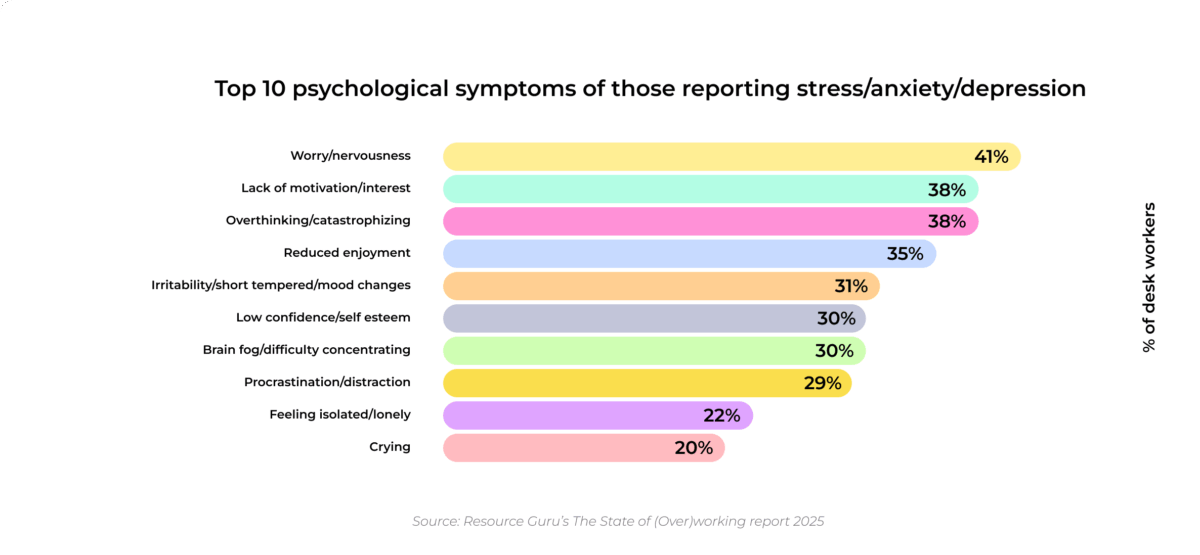
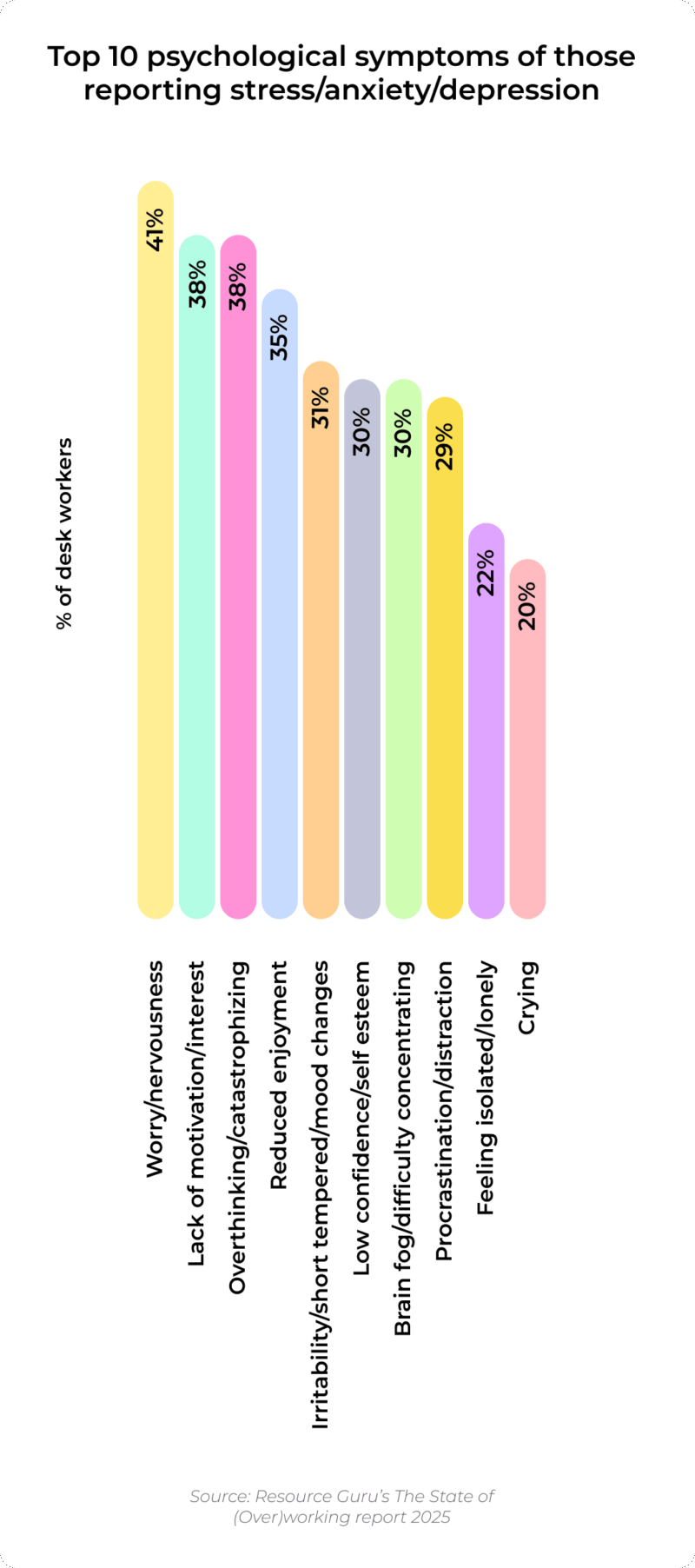
Additional concerning symptoms:
Although most people associate burnout with psychological symptoms, there are physical ones too.
“In the past I’ve experienced a variety of anxiety-driven physical ailments. Sleep issues, eczema, swollen throat, dehydration, eye lid spasms, nausea.”
– MK, Lawyer, Anonymous
Dr. Matthew tells us that, “it’s important to remember that the mind and body are closely intertwined, and these physical issues can definitely signal that something is not right.
For many people, they haven’t realized the level of burnout or mental burden from work until after these physical symptoms show up and they put two and two together.
In terms of longer-term health impact, consistent stress can develop into more serious health conditions like heart conditions and a weaker immune system. And, in general, it can take longer for the body to recover from many illnesses.”
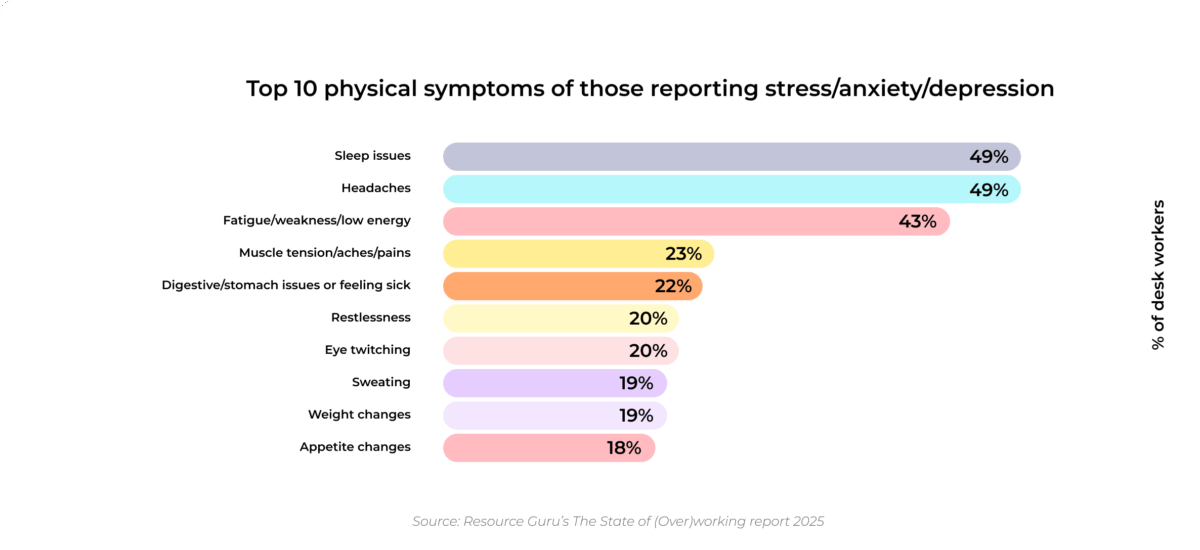
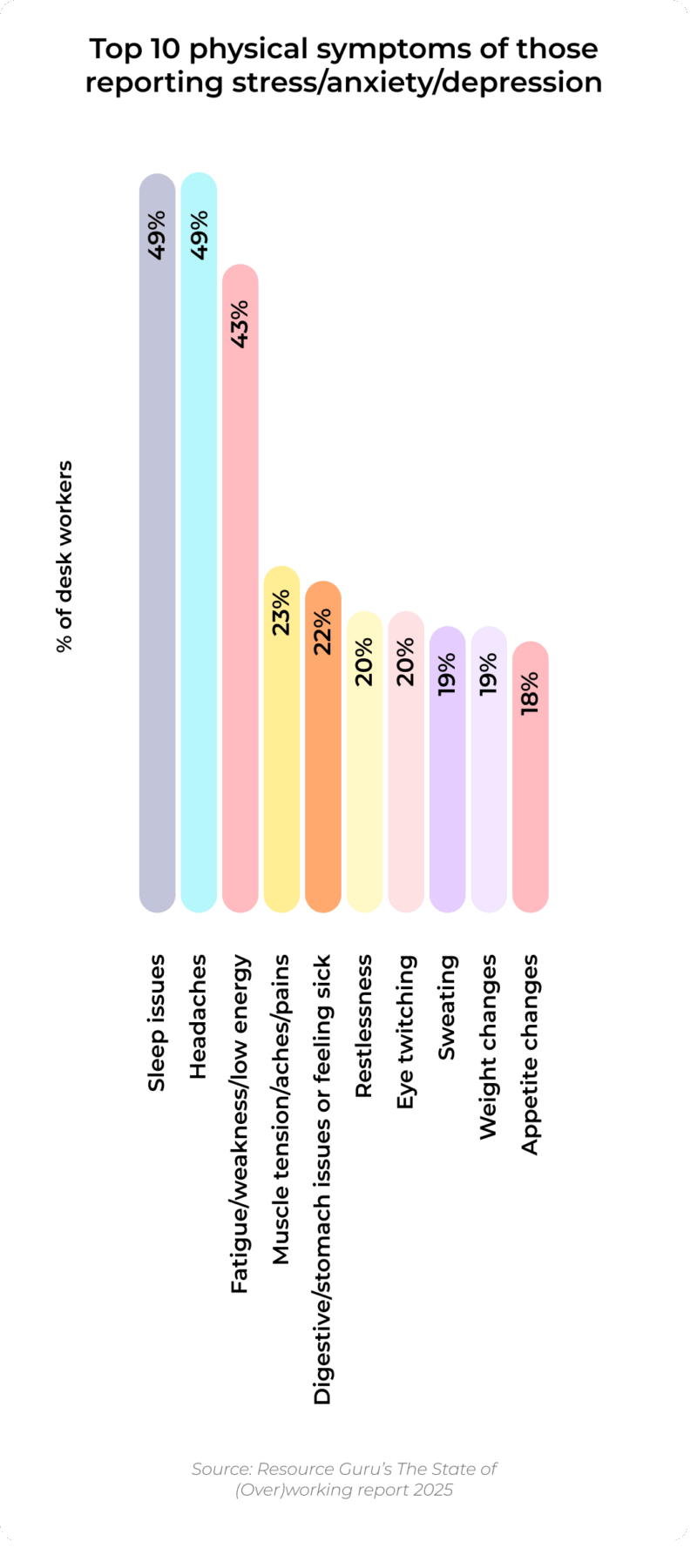
Additional concerning symptoms:
Hot take:
“This data is evidence that it’s not just in “people’s heads”. Sometimes, employers don’t take staff stress seriously until it’s already physically manifested. But by this point, the situation has already become pretty serious.” – Dr. Matthew Chan
As more employees experience the symptoms and consequences of burnout, they’re naturally relying on health services to help them.
“There often is no quick fix to these problems, no Ctrl-Z to undo the damage immediately. But, the numbers are clear—if workers are requiring medical interventions at this scale, burnout isn’t just a buzzword, and we need to be tackling it proactively, starting from the workplace.”
– Dr. Matthew Chan
He adds: “For me, these statistics highlight two societal strains.
Firstly, we can see immense pressure on healthcare systems to keep up with the demand. I think it’s easy to write off the issue of burnout as just a transient ‘hot topic,’ when in fact we are in the midst of a public health crisis.
And secondly, there will be a huge cost to businesses, from lost productivity and time off to go to these medical appointments, through to increased staff turnover.”
We’ll cover more about this next.
It’s easy to think of overworking and burnout as just an individual problem, but it runs much deeper than that. People power is the backbone of good businesses.
Hot take:
“I strongly believe burnout should be one of the CEO and CPO’s top strategic priorities.” – Leanne Spencer
Leanne shares that these issues have a clear cost for businesses, as they impact:
1. Staff absenteeism and turnover
“Burnout causes workers to need time off because they’ve been pushed past their limits. Precious resources such as energy, mood, and motivation are finite and need to be replenished. If they’re constantly depleted, it can lead to cumulative wear and tear on the body and brain.
This is called allostatic load. When we are constantly exposed to pressure such as tight deadlines, long hours, and lack of recovery, our stress response stays switched on. High allostatic load erodes resilience, impairs decision making, and leaves people physically and emotionally depleted.”
Being too stressed and having too much work may even lead to employees handing in their notice.
Overall, overworking becomes a time paradox. Putting in excessive hours worked upfront is not sustainable, and can just lead to a loss of hours worked down the line.
“There’s a clear loss of potential productivity and revenue if employees are off work sick, or signed off with stress.
Retention rates decreasing also has a very clear cost to the business.”
– Leanne Spencer
2. Quality of work and innovation
According to Leanne, “burnout undermines innovation, decision making, and morale, especially in high-pressure environments,” and the stats back this up:
“You’re more likely to make mistakes when you’re tired or if you’re being rushed. How can you really think clearly? How are you doing your best work under those circumstances?”
– MS, SEO & Content Consultant, Freelance
3. Productivity, performance, and presenteeism
Just because you’re at work, doesn’t mean you’re doing your best work. Leanne explains that “presenteeism is insidious; someone might appear to be productive and dedicated, but their productivity levels are diminishing.”
Again, this is reflected in the data. Of those reporting work-induced stress, anxiety, or depression:
4. Staff morale and quiet quitting
“Quiet quitting is where employees do the bare minimum required. They stop going above and beyond because they feel disengaged, undervalued, or burned out. For many, quiet quitting is a way of setting boundaries, or reclaiming work-life balance.” A lack of motivation or interest is a tell-tale sign of quiet quitting.
5. Business reputation
As the topic of overworking and burnout gets more airtime, mindsets are changing. Employees still care about salaries and financial security, but they’re looking for more than just a paycheck. They want to feel supported, valued, and are more likely to seek work-life balance. So, any business ignoring these areas is going to appear less appealing and competitive.
Leanne explains that, “businesses are judged by how they treat their people. The health of your people is the health of your business. In a climate where talent is becoming increasingly selective and values-driven, ignoring burnout risks both reputation and results.”
“It’s clear that overworking is not just a personal problem for employees—it’s a huge business risk. Just as businesses look out for and address all kinds of operational and competitive risks, they also need to be proactive about managing their human resources carefully.
Ultimately, businesses are nothing without their people, and it’s only a matter of time before the effects of overwork and occupational burnout show up negatively in business metrics and outcomes.
So, it’s not that getting ahead on these issues is just ethically the “right thing” to do for your team—it’s essential to position a business for long-term success.”
– Dr. Matthew Chan
Now that we understand the impact on both employees and businesses, let’s peel back some of the specific risk factors to identify the key root causes. Below, we’ve summarized three overarching themes contributing to overworking and burnout, as guided by the survey data and our experts.
It’s not that people are unaware of the culture of overworking in the UK, it’s that they’ve accepted it. The harmful notion of “getting the job done at any cost” has wormed its way into the public psyche, at the cost of workers’ wellbeing.
“We live in a culture that still venerates hard work and overworking as a badge of honor.”
– Leanne Spencer
Meredith adds: “Being able to say ‘no’ may either be tied back to a lack of unclear goals and alignment. Or, a culture and belief that overwork is a sign of commitment. This can be damaging to both employees and businesses.
For employees, it creates a cycle where they feel like the only way to succeed is to accept more work, even if it’s at the cost of their well-being. It means sacrificing any sort of home and work balance, feeling stressed, and eventually burning out.”
“When I worked at agencies, there was a real culture around fear of pushing back and saying you don’t have time to do something, because you think it will make you look incompetent, lazy, or you’re avoiding work. That’s a deep cultural problem.”
– DD, PR & Partnerships Manager, Fender
Being allocated (A.K.A assigned) too much work leads employees to work longer hours, and eventually burnout.
To add insult to injury, a large proportion of desk workers surveyed don’t have any mechanisms in place to even try to balance workloads.
“I really empathize with these statistics because I’ve seen first-hand how unmanageable workloads and being assigned too much work can lead to burnout issues. In my experience, overworked employees are nearly always a symptom of poor scheduling.
We’ve also heard stories from many Resource Guru customers about what their workloads were like before using our software, and how better resource management is now saving their teams from being overworked, as well as creating efficiencies that allow them to hire more people.”
– Percy Stilwell
Hot take:
“Let’s be real – free food and perks aren’t going to fix these problems, although they might put a temporary band-aid on them. Rather, businesses need to review how they structure workloads and resource work, to get the most out of their employees in a sustainable rhythm.” – Dr. Matthew Chan
Guestimated schedules are making expected delivery times a nightmare.
And, employees are being forced to make undignified sacrifices to get their tasks over the line.
But, knowing the actual time spent on work is tricky if you don’t have accurate ways to track it. That’s because you need data from the hours spent on past projects to help teams predict how long future projects will take (and by default, set manageable deadlines).
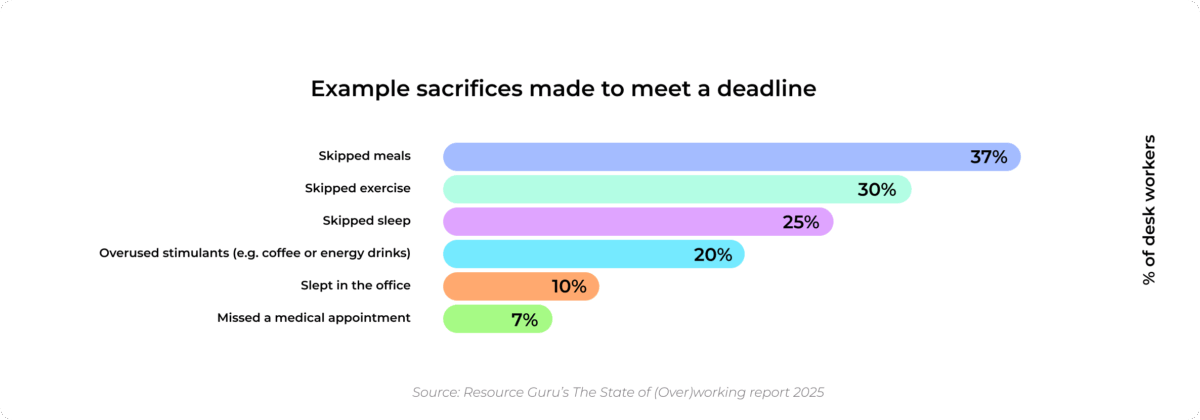
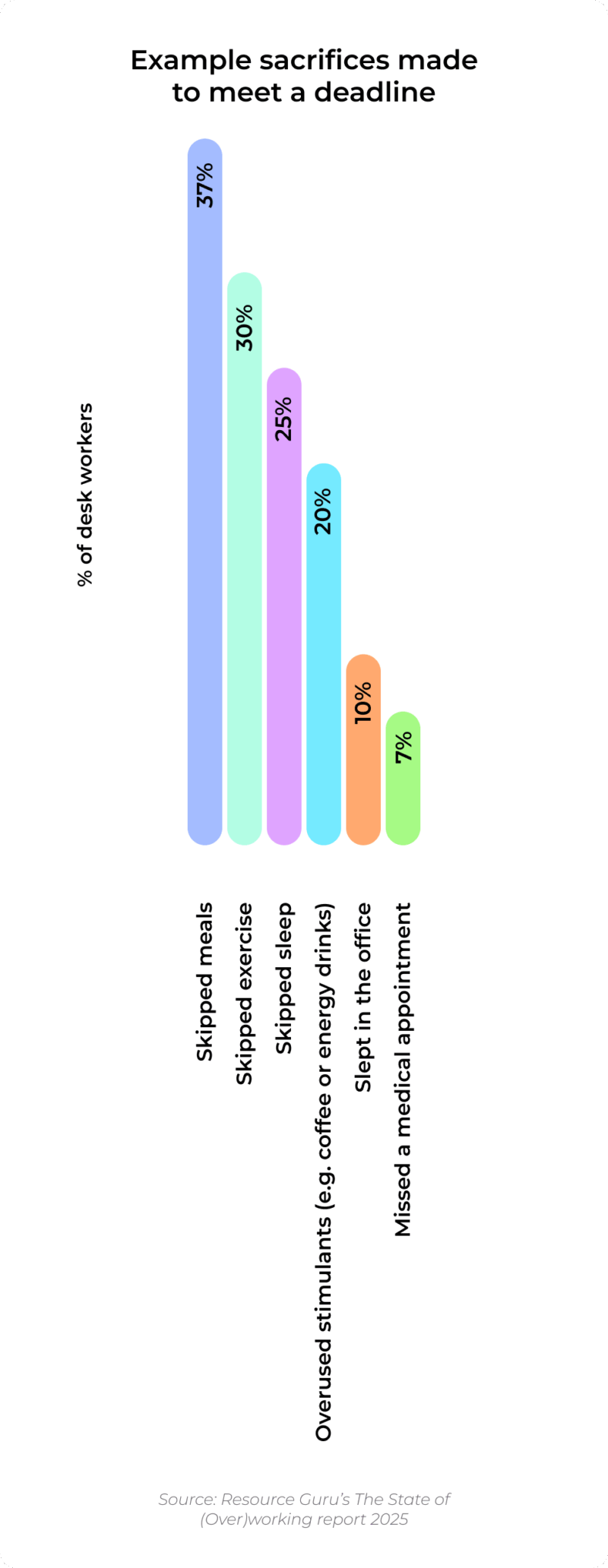
A closer look into tough deadlines and skipping meals from Aron Snowsill 👇
Sometimes a vicious cycle can occur:
A closer look into tough deadlines and exercise from Matthew Anstey 👇
If someone develops a pattern of skipping exercise to meet a deadline, it can definitely accumulate and lead to stress.
Exercise is a proven stress reliever as it enhances the production of endorphins, (nature’s ‘happy hormones’). Replacing workouts with work removes this critical coping mechanism, making it harder to decompress and manage pressures.
If you’re working long hours or have limited time due to deadlines, “quality” (such as shorter, high-intensity workouts) over “quantity” can be a practical approach to maintain exercise without overwhelming your schedule.
A closer look into into tough deadlines and skipping sleep from Leanne Spencer 👇
Sleep is a force multiplier for boosting energy, mood and motivation, and we need good quality sleep to thrive.
A lack of sleep can affect our ability to concentrate, retain information and apply critical thinking skills. Over time it will erode performance and have detrimental effects on the brain and body.
Prioritising good sleep is a great example of ‘deliberate rest’, a term coined by Alex Soojung-Kim Pang. The restorative effects of a solid night of sleep are a fantastic way to boost recovery. So, skipping sleep to meet deadlines is going to have an impact on your work performance in general.
“One of the biggest issues for me is insomnia. I can’t sleep if I’m stressed about deadlines. So I end up just sleeping for 4 or 5 hours. A few years ago I even worked all night in the office once, only to go back home at 7am to shower and then go back to the office to work…so I got absolutely no sleep that night.”
– CG, Director, Deloitte
A closer look into tough deadlines and stimulants from Aron Snowsill 👇
What goes up must come down! Although you get momentary energy from caffeine, you will also experience the drop-off when the caffeine wears off. This makes focusing on your work challenging.
You will compensate by consuming more caffeine from coffee or energy drinks. This can in fact worsen your productivity, negatively impact your concentration levels, and make it harder to hit deadlines.
Using stimulants can also lead to feelings of anxiety and jitteriness (think wired but tired). You’re quite literally drinking stress in a can.
According to these figures, work-life balance is diminishing due to deadlines.
Dr. Amani explains that this is because, “overwork can make someone feel like their job is their whole life, leaving little room for their role as partner, parent, or friend.” Naturally, social events and personal plans will start to become deprioritized.
“In a past role, I was asked to be Creative Lead on one of the biggest projects of the year, which was a great opportunity for me. However, my boss told me that if I took my annual leave to go on a family holiday, I wouldn’t be assigned the project. This created a real dilemma for me and I definitely experienced guilt around taking time off and spending time with my family.”
– EC, Senior Creative Designer, Gousto
We know that overworking impacts mental health, but a quarter (25%) of respondents said their company doesn’t do anything to support mental health. However, some desk workers reported that their company has put reactive measures in place, such as:
But, is reactivity enough?
“Reactive measures have a place, but it can be rather like locking the door after the horse has bolted.”
– Leanne Spencer
Leanne adds: “Companies that care about their team will address systemic issues and have preventative strategies in place which focus on the sustainability of people. This relates to employees having the energy to remain productive and efficient over time, without burning out.
As more businesses focus on ESG (Environmental, Social, Governance) and broader sustainability goals, we should include a P in ESG, the P representing people. This will showcase how much a business and its leadership team are concerned about the sustainability of its people.”
We worked with our experts to identify proactive, preventative measures to tackle each of the three key overworking themes, and to help stop burnout happening in the first place.
4 solutions from our experts:
1. Start with wellbeing policies
Meredith says: “When creating wellbeing policies, it’s important they reflect the reality of your business and the people in it. That means consulting everyone on your team, including young workers and those from minority or marginalised groups, to ensure your approach supports both your current team and future hires. Also, make sure policies evolve based on feedback to stay relevant, inclusive, and effective.”
“We need sustainable people to drive sustainable businesses and solve meaningful problems.
We need to address all the factors of burnout, and put the focus on wellbeing as an integral part of any high performing culture.”
– Leanne Spencer
2. Implement change from the top down
Meredith’s advice is to “train managers to recognize burnout early, and make sure they know how to support staff when they’re struggling. Managers should be well-versed in policies, capable of setting boundaries, and fostering a culture of openness.” She adds that “it’s important to note that this can’t sit with managers alone. You need the right systems, processes, and leadership buy-in to make support consistent and scalable.”
Pro tip:
“Leaders should make it clear they do not expect people to push past their boundaries or limits except if it’s business-critical or on the rare occasion.
Managers should role model desired behaviours and have the emotional intelligence (or good training) to understand the personality of each team member. Those with people-pleasing traits or younger members of the team might struggle to impose boundaries. A good leader will know this and step in.” – Leanne Spencer
3. Focus on outcomes, not outputs
Meredith stresses that “businesses need to be clear about expectations and reinforce that reaching success is about business outcomes, not the hours worked. And, recognition shouldn’t just be about hours worked. Reward good performance and results, and recognize employees who prioritize their wellbeing. When people feel they can set healthy boundaries without losing out, it creates a culture where people are both productive and happier.”
“I think a lot comes back to the culture in the business. I make a real point of not rewarding late workers in my current role and actually challenge those that do stay late, as project managers should be good keepers of time and not be hanging around.”
– RW, Head of Global Marketing Operations, Anonymous
4. Create an environment of psychological safety
According to Meredith, it’s important for managers to “create a culture of transparency, where employees feel comfortable sharing concerns about their workload without fear of judgment. Regular check-ins and short feedback loops are going to help with this. Have conversations to check-in. They’ll help catch signs of burnout early, so we can provide the support people need before things escalate into a danger zone.”
Pro tip:
“Taking the time to foster a culture of psychological safety, flexibility, and support across seniority levels is also key, to enable employees to do their best work and build a thriving business.” – Dr Matthew Chan
Putting in these preventative measures and shifting company culture will naturally influence individual mindsets, where employees feel like they can put in boundaries without feeling at risk of not being recognized or rewarded.
Advice from our experts:
Leanne suggests implementing the Cadence Approach™ to resource management. This methodology shifts the focus from constant output to smart, sustainable performance.
“Make sure workloads are reasonable and achievable, and assess them regularly to avoid stress and burnout. No business can afford to ignore this. It’s a false economy to push people too hard if it means they leave or go off sick.” – Meredith Lawlor
Percy tells us that “the right resource management tools can help businesses implement this type of framework by:
It’s so important to have the ability to plan ahead, and not just react to issues as they surface.”
With our expert input, we’ve broken the solution into 3 steps:
Step 1: Gather project data
It’s impossible to set sensible deadlines without accurate information to guide timelines. Using real data from past projects lets teams accurately forecast, meaning employees won’t get burned out trying to meet unrealistic deadlines.
“Anticipation is key. Business is more predictable than we think, so realistic planning is required,” says Leanne.
Step 2: Project planning
It’s important to not only plan the project needs, but also make sure the right people are in place to meet those deadlines. “Anticipate what will be required in a project in terms of resources,” says Leanne.
And, it’s not just about planning upfront, it’s about monitoring the plan as you go. See what’s off-track and update deadlines when needed. That way teams won’t become overworked and stressed, just to keep up with an initial timeline that no longer makes sense.
Step 3: Factor in project breaks
Leanne encourages managers to ask the following questions:
Meredith agrees: “We need to make it okay for employees to take breaks, take time off when they’re sick, or use their annual leave without guilt. Fostering a culture that supports a good balance and encourages regular breaks helps employees manage their wellbeing in a healthier way.”
Percy shares: “It’s thought that a utilization rate of around 70-80% is optimal, allowing a buffer for unexpected work, creative thinking, and much needed breaks.
Project scheduling tools can help execute project planning steps with ease. You’ll also be able to assign the right people to projects, adjust deadlines, and factor in downtime while keeping everyone in the loop.
Time tracking tools can help gather actual data which you can then compare to scheduled time to see where there could be unhealthy patterns developing. You can also use this data to shape future estimates and set more realistic deadlines.”
Too often, resource management tools focus on tasks instead of the people completing them. However, in a world where many employees are overworked and burned out, Resource Guru puts people first.
Resource Guru’s software is a fast, flexible solution that acknowledges a happy, healthy team is good for business. We offer specific, unique features that helps you answer these types of questions:
Resource Guru helps businesses streamline resource scheduling, implement time management, and ultimately achieve project success.
“We believe time is the single most valuable commodity in life, and is one of the reasons we built Resource Guru back in 2011.
We know people do their best work when they’re not rushed. And that over-allocation should be the exception, not the rule. Life is best when there’s a good balance between work and everything else.”
– Percy Stilwell

1. Resource management schedule: Avoid an ad-hoc approach to scheduling resources, allocating them to projects, and seeing who is working at capacity. This prevents overworking for in-demand employees.

“Work is stressful, and in this day and age keeping track of things becomes tedious. But with Resource Guru, I am able to view my schedule whenever I want and keep my life on track and make plans ahead.”
2. Timesheets and time tracking reports: This data reflects actual hours worked, so you can see where team members are really spending their time, compared with what was forecasted. This improves workloads for anyone working excessively, and helps avoid burnout.
3. Clash management: Clash notifications signal when allocating work to someone who is already booked, or unavailable. This prevents conflicts and stops overloading employees.

“Resource Guru helps prevent scheduling conflicts and keeps track of team availability in real time. It makes project planning smoother and ensures balanced workloads, saving time and reducing stress.”
4. Waiting list: Bookings that don’t fit in someone’s availability can be added to a waiting list, ensuring team members at capacity don’t become overburdened.
5. Approval workflow: Provides extra control over who can approve bookings for employees. This protects the time of in-demand teammates and ensures that work is allocated fairly.
6. Utilization rate tracking: Monitor team utilization, compare forecasts and actual time spent, use data to spot when employees have too much on their list.

“It’s amazing! It is critical to our weekly resource planning. It’s helped us ensure that critical project demands are being met and that individual staff are not overloaded.”
7. Leave management: Create, manage, and get visibility for time-off in advance. Plan for absences ahead of time, so that other team members aren’t given additional work last minute, and then burn out.
8. Default availability: Set particular working hours for each employee to stop bookings being made outside of available hours, so that employees don’t have to work during unrealistic times.

“Time saving, stress saving and it helps everyone. Top product that I’m glad is part of the business’ routine.”
9. Availability bar and heatmap views: Easily scan for availability at a glance. Team members with utilization or availability issues will be flagged so that managers can prevent overworking issues.

Find out how you can streamline resources, manage time, and achieve project success

“The results of this survey are concerning, but it doesn’t have to be this way.
The features listed above were designed to reduce excessive workloads, boost morale, increase productivity, and help improve employee absenteeism and churn.
After all, happy teams are good for business.”
– Percy Stilwell
Methodology & notes:
This online survey of 2,000 UK desk workers was commissioned by Resource Guru and conducted by market research company OnePoll, in accordance with the Market Research Society’s code of conduct. Data was collected between [07/02/2025] and [19/02/2025]. All participants are double-opted in to take part in research and are paid an amount depending on the length and complexity of the survey. This survey was overseen and edited by the OnePoll research team. OnePoll are MRS Company Partners, corporate membership of ESOMAR and Members of the British Polling Council.
Respondents were screened to confirm they worked primarily at a desk in an office or home setting.
The sample included a mix of respondents across age groups, genders, industries/job roles, and UK regions.
Expert commentary was gathered after the survey was completed, based on a summary of the key findings.
Media pack:

Our interactive Burnout Risk Index, developed with burnout expert Leanne Spencer, reveals 10 red flags which shows that you or a team member may be on the way to burning out.

Job stress (including burnout) costs American employers over $300 billion annually. Low employee engagement—a common burnout symptom—costs the global economy $7.8 trillion annually. Burnout spans across industries, but some are more at risk than others. Data…

Amirreza Farhadi is the Associate VP of Operations at Havas CX Canada. Part of Havas’s senior leadership team, he builds, monitors, and improves processes to ensure the business runs smoothly. In his eyes, that starts with…